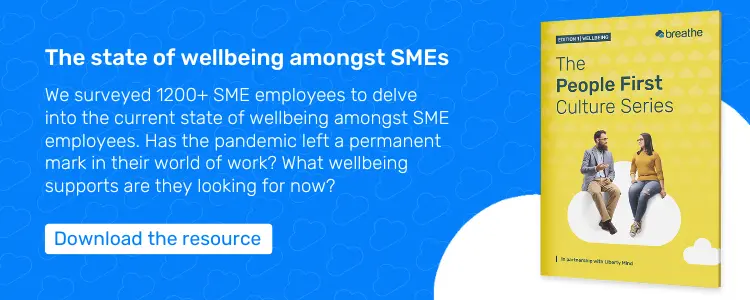Cold, dark and wet. Winter is pretty miserable for most of us Brits.
But, for people affected by seasonal affective disorder (SAD), it’s almost unbearable.
In the UK, 1 in 20 people are diagnosed with SAD - and men are more likely to be diagnosed than women are.
Given how common seasonal affective disorder is, as an employer it’s important that you’re aware of the condition so that you can support any team members who may suffer during the winter months.
In this blog, we’ll cover:
-
Does SAD make you tired? Symptoms of seasonal affective disorder
-
5 employer tips to support a team member suffering with SAD
What is seasonal affective disorder (SAD)?
Seasonal affective disorder (SAD) isn’t just the reluctance to go outside on a grey and gloomy day. It's a type of depression, sometimes referred to as “winter depression” because of its close links to winter and reduced sunlight.
It’s believed that a lack of natural daylight stops a part of the brain - the hypothalamus - from working properly. This can raise levels of melatonin, making sufferers feel sleepier than usual. It can also lower serotonin levels, resulting in feelings of depression, too.
What’s more, the lack of sunshine is believed to affect your body’s internal clock, leaving your natural rhythms out of sync.
Does SAD make you tired? Symptoms of seasonal affective disorder:
SAD can make many people feel more tired than usual, or find themselves wanting to sleep more. According to the NHS, people suffering with SAD may experience the following symptoms:
-
a persistent, low mood
-
feeling lethargic (lacking in energy) and sleepy during the day
-
a loss of pleasure or interest in normal everyday activities
-
irritability
-
feelings of despair, guilt and worthlessness
-
sleeping for longer than normal and finding it hard to get up in the morning
-
craving carbohydrates and gaining weight
5 employer tips to support a team member suffering with SAD
Given how common it is, there’s a strong possibility one or more of your employees suffer from SAD. And if isn’t managed, SAD can really take its toll.
In other words, you’ll have increased absence and reduced productivity to contend with.
It’s also important to consider the link between depression and increased physical health problems and weaker immunity.
If left unaddressed, depression and anxiety can mean your employee’s physical health can take a hit – which, again, is bad news for productivity.
It’ll also have a knock-on effect on the rest of their team, as they’ll have to pick up their teammate’s workload in their absence.
So what can you do to help? Well, as their employer, while unfortunately you can’t cure an employee of SAD, you can certainly support them.
Here are 5 top-tips from us on how to help an employee who is suffering from SAD.

1. Encourage an open and supportive company culture
One of the most important things you can do to help employees suffering from SAD and other mental health challenges is to have an open and supportive company culture.
If employees know you’ll support them and won’t judge them, you remove a source of stress, making it easy for them to focus on their job and health without fear of consequence.
2. Make mental health in the workplace everyone’s business
A company culture that prioritises good mental health thrives.
Training managers to spot and deal with mental health issues will help everyone in your organisation.
A company culture that is open about mental health in the workplace means employees feel they can talk to you and be more likely to seek appropriate treatment.
An excellent way of raising awareness about SAD is to leverage World Mental Health Day on the 10th October. It’s just before the clocks go back - a trigger point for many sufferers.
We've put together a guide to mental health in the workplace which provides some super-useful and practical tips on how to promote mental health among your employees.
3. Focus on wellness all year round
Ensuring an all-year focus on wellness will mean you’ve already taken care of many of the considerations you need to bear in mind for SAD.
Exercise and plenty of natural daylight are two prime SAD self-help methods.
Ensure everyone in your team can leave the office for fresh air and a walk when they need to. Walking meetings or a stroll to a local shop might just be enough for vulnerable employees to keep things in check.
4. Maximise your workplace layout
Sadly, many workplace buildings were not designed to prioritise the flow of natural daylight.
But, you can take steps to maximise natural light for your employees. Taking positive steps to improve natural light in your workplace benefits everyone - not just sufferers of SAD.
Open blinds fully and make sure your windows are clean. Remove posters or other obstacles that block the flow of natural light. Window seats are popular in most offices but prioritise these seats for known SAD sufferers instead of the folk who simply like to see what’s going on outside.
What if your workplace has minimal or no windows? Here are a few suggestions:
-
If you own the building, consider installing roof windows or light tunnels to let natural daylight into your workplace. If you don’t own the building, you might be able to persuade the building owner to do this for you.
-
Actively encourage everyone to spend part of their day in natural light; for instance you could insist everyone eats their lunch away from the office.
-
Invest in some daylight lamps to help those who are vulnerable to winter depression.
5. Get flexible
Remember that reasonable adjustments to help employees with mental health struggles also include necessary time off for medical appointments with their GP and counsellor/therapist. In addition, you may need to consider:
-
A later start time to allow sufferers to spend time in daylight.
-
A temporary change to shift patterns so sufferers can maximise their time in natural daylight.
-
Permission to take all or a majority of holiday allowance over this time – time in the sun over the winter months can help SAD sufferers.
Supporting your team's mental wellbeing
Following these steps will support your employees and show them you’re on their side. SAD might only affect some employees for part of the year, but a year-round focus on mental health care supports everyone and makes good business sense.
Find out about the wellbeing supports SME employees really value in our People First Culture Series research: edition 1, wellbeing.

Author: Aimée Brougham-Chandler
An IDM-certified Digital Copywriter as of February 2023, Aimée is Breathe's Content Assistant. With a passion for guiding readers to solutions for their HR woes, she enjoys delving into & demystifying all things HR: From employee performance to health and wellbeing, leave to company culture & much more.





